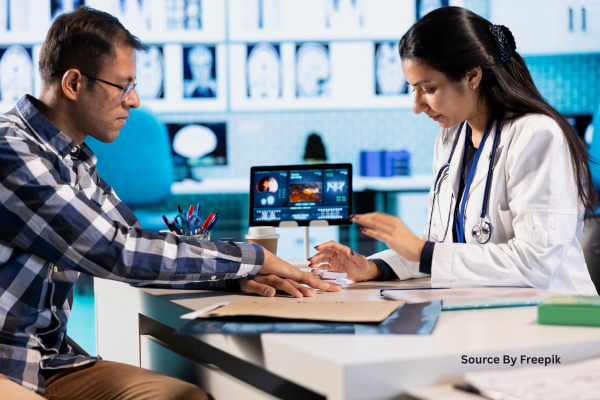When patients return to the hospital soon after being discharged, it often means their recovery did not go as planned. These readmissions can be stressful, expensive, and sometimes even dangerous for patients. They also put a lot of pressure on healthcare systems. In today’s world, new technologies are making it easier to care for patients after they leave the hospital. One helpful tool is remote monitoring, which allows doctors to check on patients without needing them to come back in person.
Why Do Hospital Readmissions Happen?
Hospital readmissions are more common than you would have imagined. It usually occurs due to a lack of proper attention from the medical expert and unawareness in patients about the signs of improvement. These and many other reasons can contribute to the consequence of people returning to the hospital, such as:
-
Not fully recovering from an illness or surgery
-
Not understanding how to take medicines
-
Missing follow-up appointments
-
Not knowing how to manage their health at home
-
New symptoms or complications
Certain conditions, like heart failure, pneumonia, and diabetes, increase the risk of being readmitted. In many of these cases, early action could prevent the need to return to the hospital. That’s where remote monitoring can make a big difference.
What Is Remote Monitoring?
Remote monitoring, also called remote patient monitoring (RPM), uses devices and apps to track a person’s health from home. This data is then shared with their doctor or care team. Below are some of the most common tools utilized with the remote patient monitoring solutions:
-
Blood pressure monitors
-
Blood sugar meters for diabetes
-
Scales to track weight gain or loss
-
Pulse oximeters to measure oxygen levels
-
Smartwatches or wearable devices that track heart rate and activity
These tools let doctors see how a patient is doing in real time. If a problem starts to show, the doctor can take action before it becomes serious.
How Remote Monitoring Helps Prevent Readmissions
Remote monitoring helps in many ways. Here are some key benefits:
-
Early Warning Signs
-
Doctors can catch changes in a patient’s condition early. For example, a sudden rise in weight could be a sign of fluid buildup in a heart patient.
-
Low oxygen levels might mean a lung infection is getting worse
-
Unusual blood sugar levels in a diabetic patient may need immediate attention
-
Spotting these signs early can help prevent a return trip to the hospital.
-
Better Medication Management
Patients often get new medications after being discharged. Remote monitoring helps doctors see how those medications are working. If a patient has side effects or misses doses, the care team can step in quickly.
-
Improved Patient Engagement
With remote monitoring, patients become more involved in their care. They can:
-
Track their own health numbers
-
Understand what those numbers mean
-
See how small changes in their daily habits affect their recovery
-
This gives patients more control and helps them feel confident managing their health.
The Role of Remote Patient Monitoring Solutions
Using remote patient monitoring solutions, healthcare teams can stay connected with patients after they go home. These systems:
-
Send automatic alerts when numbers go outside of safe ranges.
-
Allow for video calls or chats between patients and doctors.
-
Keep track of health trends over time.
These tools are especially useful for people with long-term health problems or recent surgeries. They give doctors a full picture of how recovery is going, without requiring the patient to visit in person.
Supporting the Transition from Hospital to Home
Leaving the hospital can be a confusing time. Patients may not fully understand what to do next. Remote monitoring can guide them during this period by:
-
Sending reminders for medications
-
Monitoring vital signs daily
-
Giving tips on diet, activity, and rest
-
Notifying doctors if anything looks unusual
This extra support can reduce stress and make the recovery process smoother.
Easier Coordination for Care Teams
Doctors, nurses, and other health professionals often work together to care for one patient. Remote monitoring helps them share important information quickly. Everyone can stay updated on:
-
The patient’s current health
-
Any new symptoms or side effects
-
Progress with recovery
-
This teamwork helps avoid mistakes and leads to better results for the patient.
Cost Savings and Better Health
While setting up remote monitoring may require some costs at first, it saves money over time. It:
-
Prevents emergency room visits
-
Reduces repeat hospital stays
-
Helps patients avoid health complications
In the long run, remote monitoring leads to better health and lower medical bills for both patients and healthcare providers.
Final Thoughts
Remote monitoring is changing how we care for patients after they leave the hospital. It offers early alerts, supports recovery, and helps people manage their health better at home. With fewer surprises and faster responses, the chance of going back to the hospital goes down.
At CareIQ, remote monitoring is part of a thoughtful approach to improving patient outcomes. By using smart tools and simple tracking, patients and doctors can work together for better, safer care, no matter where the patient is.


